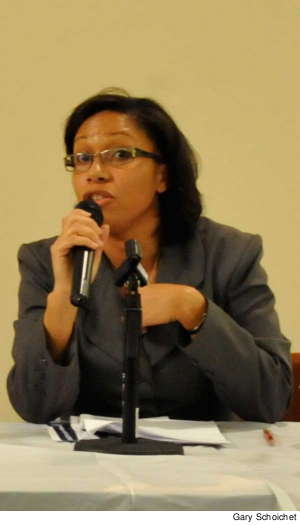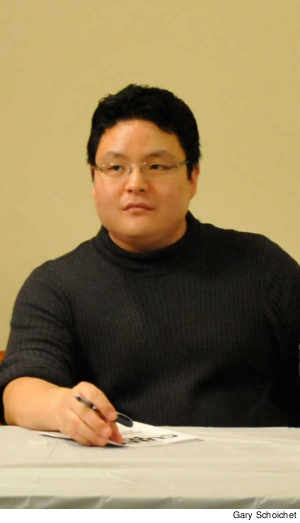A hundred people gathered at the end of Fall semester for an update on the PSC’s ongoing study on how race, gender and ethnicity affect hiring, promotion, tenure and reclassification at CUNY. The December 9 forum at City Tech presented information on the project and some of its preliminary findings, followed by discussion led by the study’s research team and members of the union’s CUNY and Race Advisory Council.
 |
“The large turnout and the comments at the forum demonstrated two things,” said Jonathan Buchsbaum, a PSC Executive Council member and co-chair of the union’s Anti-Racism Committee. “Members want to see the PSC take an active role in improving CUNY’s record on race, and they are eager to hear the results of the union’s study .”
The evening’s first speaker was Frank Deale, a professor at the CUNY School of Law, who provided historical context. “To get some historical sense of the idea of affirmative action, you have to go back to the Civil War, to the Reconstruction Era,” Deale told the audience. It’s striking, he said, how contemporary arguments against affirmative action, in favor of what is said to be a “color-blind” alternative, are foreshadowed in those debates. Deale quoted a minority report in Congress that opposed creating a Freedman’s Bureau to provide economic benefits to former slaves because there was no such agency for white people:
“A proposition to establish a bureau of Irishmen’s affairs, a bureau of Dutchmen’s affairs, or one for the affairs of those of Caucasian descent generally…would, in the opinion of your committee, be looked upon as the vagary of a diseased brain…Why the freedmen of African descent should become these marked objects of special legislation, to the detriment of the unfortunate whites, your committee fail[s] to comprehend….”
AFFIRMATIVE ACTION
“So even going back to the period immediately after the Civil War,” remarked Deale, “you had this unwillingness to recognize that there were in fact differences between what African Americans had suffered in this country compared to the Irish, the Dutch or others ‘of Caucasian descent.’”
 |
Today, Deale noted, CUNY’s Board of Trustees is on record as supporting a policy of affirmative action, supporting “positive steps that will lead to recruiting, hiring, retaining, tenuring and promoting increased numbers of minorities and women.” He urged listeners to work toward “trying to get institutions and employers to adopt affirmative action plans on a voluntary basis,” as “the product of political struggles primarily from below.”
The next speaker was Carol Wright, lead researcher for the PSC’s CUNY and Race Project, who described the design of the PSC’s current study: a two-year research effort, it is a mixed-methods study based on both quantitative and qualitative research. The former involves analysis of CUNY-wide employment data over a ten-year period, from Fall 1999 through Spring 2009. Qualitative research includes focus groups and interviews at selected campuses, comparing some of the larger departments across those schools.
Wright holds a PhD in educational policy studies from the University of Wisconsin. As a visiting scholar and research associate at Massachusetts Institute of Technology, she worked on MIT’s school’s 2010 report on faculty diversity (see Clarion, May 2010).
Panelist Henry Park, a graduate student in developmental psychology at the CUNY Graduate Center who has worked on the PSC project, described some of the limitations of CUNY’s existing data on race, recruitment and hiring, and what this has meant for the union’s study. Data on affirmative action and recruitment, for example, existed only in hard copy and had to be entered into a database by hand. Park and Wright discussed the work that project staff have done to check the reliability of CUNY’s data, and where possible to correct mistakes or missing values.
Panelist Felipe Pimentel, assistant professor of sociology at Hostos, said he had run into similar problems with CUNY data in his own research. In the union’s CUNY and Race Project, he said, “we have to congratulate” staff on the work they have done to clean up the available data. “We have made a big investment in this project,” said Pimentel, “and I think we are going to get good results [based on] data that is much better than what we were given in the first place.”
PRELIMINARY
 |
While cautioning that the initial quantitative results were still preliminary, Wright’s presentation described a few of the main findings to date. Over this 10-year period, she said, “as a proportion of all full-time faculty, the percentages of black and Hispanic full-time faculty of all ranks has not increased. It has basically remained unchanged.” Black, full-time faculty remain at around 13% of the total, with Hispanics around 8%. While the absolute number of white full-time faculty increased, their proportion declined from 74% to 69%, while the percentage of Asian full-time faculty increased from 7% to 10%. Figures for Native Americans remained extremely low throughout the ten years, Wright said.
In the Higher Education Officer (HEO) series, Wright said, the percentage held by Asian, Hispanic and black employees did increase over this ten-year period. As with faculty, the number of white HEO-series employees rose but their proportion declined, from 54% to 45%. Wright also discussed overall data on part-time faculty (67% white at the end of the decade) and those in College Lab Technician titles (40% white at the same point).
COHORT ANALYSIS
“We are interested in career trajectories,” said Wright. “One approach to understanding this issue is to conduct a cohort analysis” – that is, to follow a set of individuals who enter a system at the same time.
 |
As a first step in cohort analysis, the study team looked at first-time assistant professors appointed in the Fall of 1999. “We are going to be looking at additional cohorts,” Wright told the forum. The numbers involved are small, and Wright emphasized that it is important not to generalize from this cohort alone. “But this is a starting place, she said, and it’s really interesting to see what happens to this group ten years later.” What stood out, Wright said, was an “exceptionally high attrition rate for black women” in that cohort – more than double the attrition rate for the cohort overall. A majority of black women hired as first-time assistant professors in Fall 1999 were no longer at CUNY ten years later. Within this cohort, black women who remained showed markedly lower rates of promotion.
“We have to see whether this pattern holds up across other cohorts,” cautioned Wright. “Nor do we know why these women left. Were they recruited away? Did they leave for family reasons? Were they denied reappointment or tenure?” Though warning against drawing any firm conclusions from this preliminary finding, Wright called it “troubling” and said it “requires further investigation.”
In February, Wright told Clarion that analysis since the forum has also found higher attrition rates for black women in other faculty cohorts. The study team is in the process of conducting cohort analyses for HEO and CLT titles, and all these results will be included when the study’s full report is released later this year.
The project is also looking at existing best practices, Wright added. “There are some very innovative and creative things going on in some departments that I’m not sure that other departments know about,” she said. “Some departments have done actually a very good job of recruiting and retaining faculty of color. Others have done a very good job of recruiting…but many of those faculty have left. So what’s going on that’s different?” Once both quantitative and qualitative analyses are complete, said Wright, the study’s final report “promises to provide a very rich record of our members’ experiences of race at CUNY.”
In the discussion period, an engaged audience posed questions and comments on both preliminary data and the historical and political context. Topics included the past role of social protest in increasing race and gender diversity in CUNY’s hiring; the importance of looking at the specific historical experience of Puerto Ricans and other national and ethnic groups, not just at broad racial categories; the need to reach out and involve organizations based in communities of color in discussions of race and hiring at CUNY, rather than limiting discussion to an in-house exchange; questions on the extent to which faculty of color at CUNY are concentrated in programs on ethnic studies or bilingual education; and many more.
TO START DISCUSSION
The comment that provoked the most responses came from Bill Ferns, associate professor of computer information systems at Baruch’s Zicklin School of Business. What’s key is “to talk about how we’re going to use the data to go back to our campuses and have a conversation about this with our colleagues,” said Ferns. “We have to deal with having those challenging conversations. It’s not easy, but that’s the only way I see that we can start moving things forward,” he said to applause.
“Talking about race is difficult, it’s problematic,” agreed panelist Iris DeLutro, PSC Vice President for Cross-Campus Units. “People are uncomfortable….But if the conversation isn’t initiated, [then] you really can’t change things,” DeLutro concluded. “It’s not an easy thing, but it must be done.”

